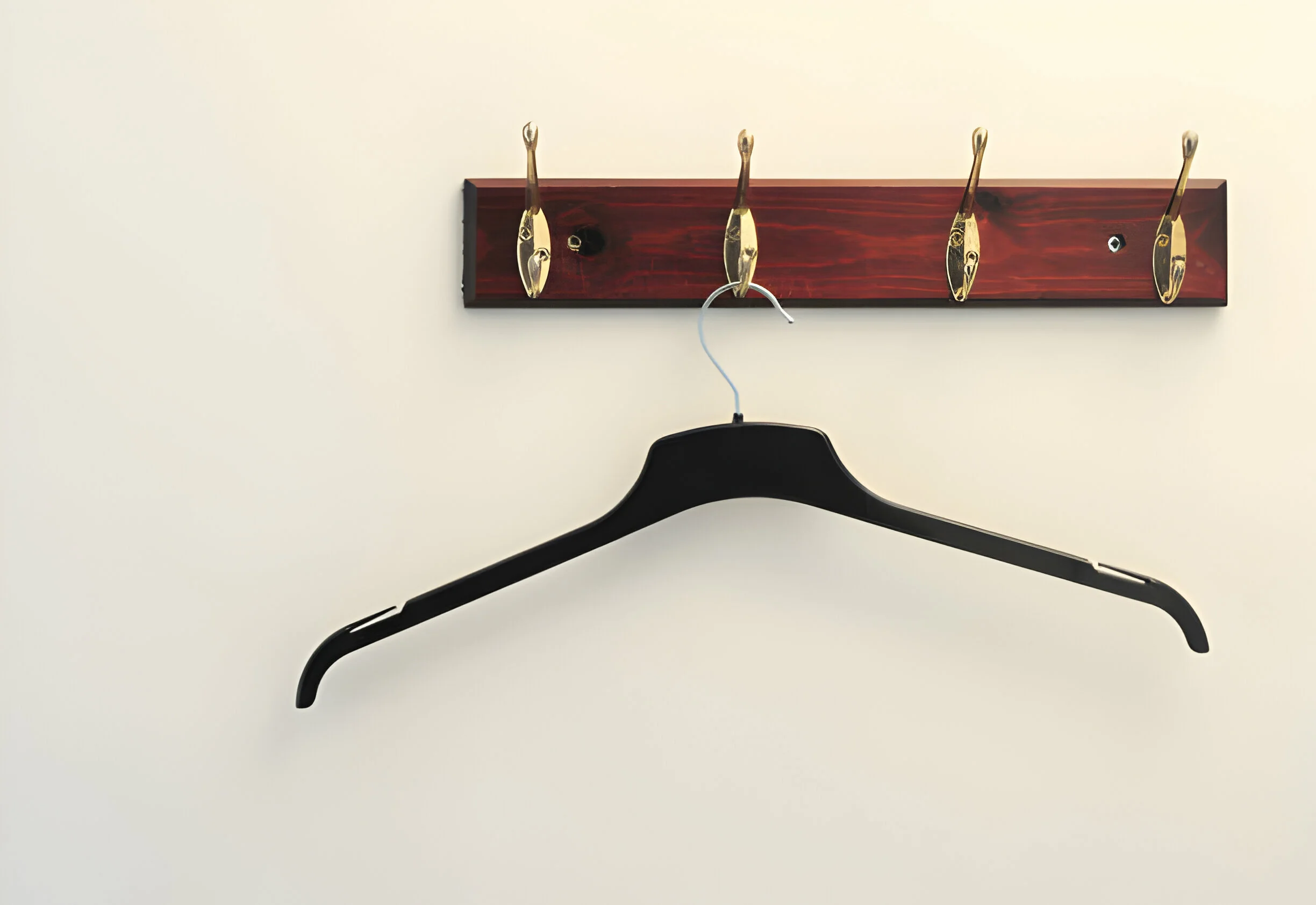A hygrometer is a device that measures the humidity and temperature of the air in a given space. It can help you create a healthy and comfortable indoor environment or monitor the moisture levels of plants or other items.
Electric hygrometers are affordable and easy to use. Some may cost more if they have extra features. Our team has researched the best hygrometers on the market and selected the ThermoPro TP49 Digital Hygrometer as our top pick. It has a long-lasting battery and shows both humidity and temperature readings.
Our Top Picks
| Image | Product | Feature | Price |
|---|---|---|---|
|
Best Overall
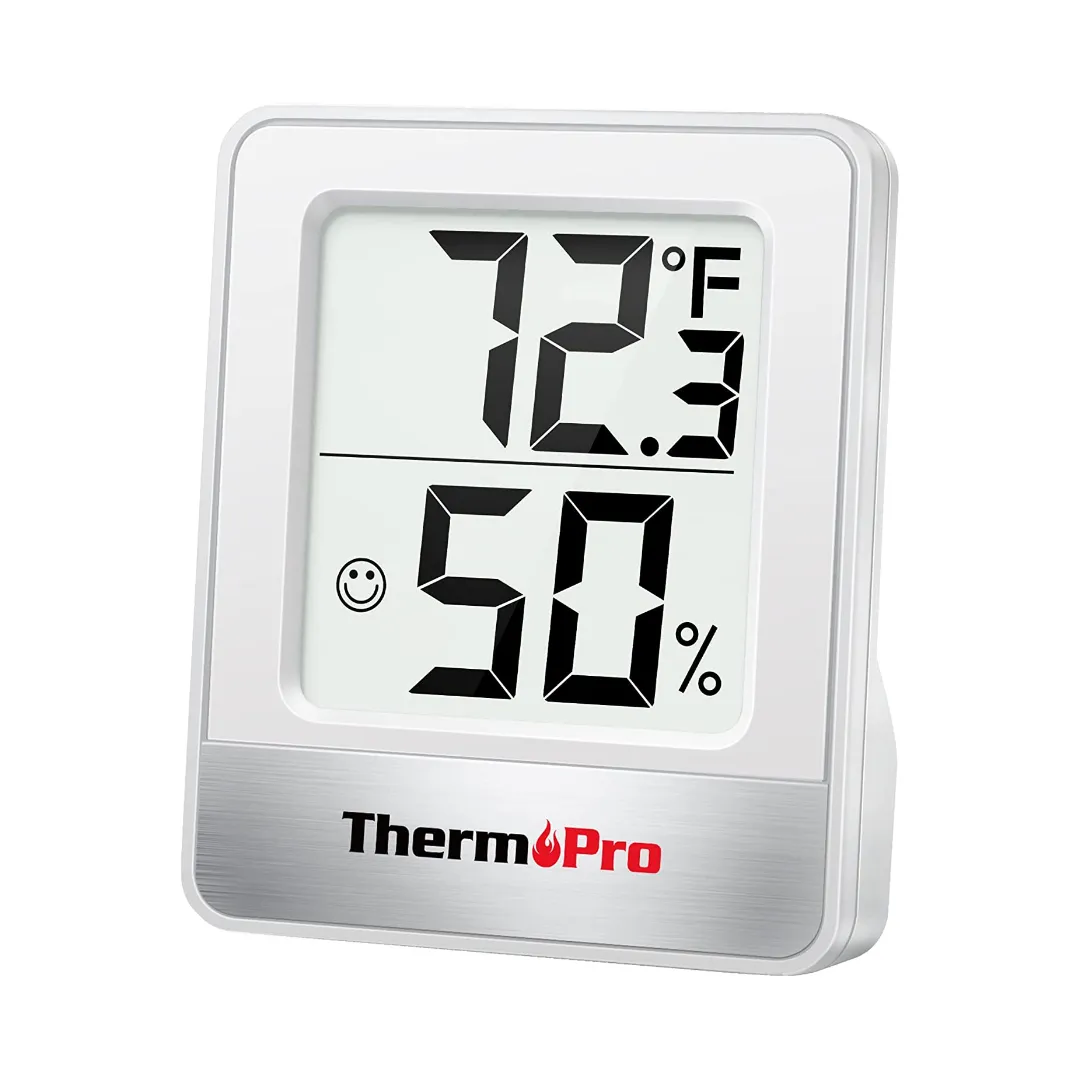
|
ThermoPro TP49 Digital Hygrometer
|
|
Check Price |
|
Best Display
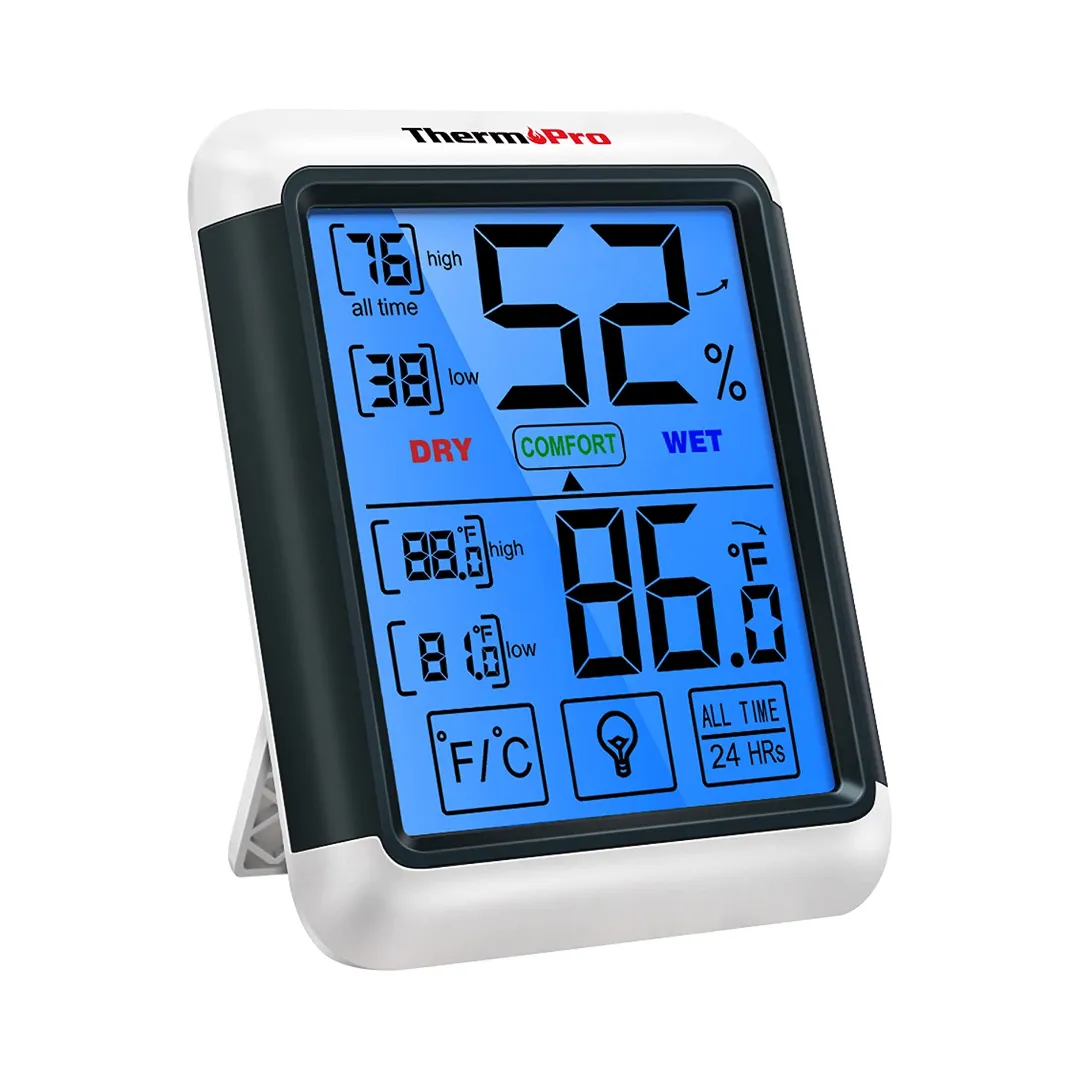
|
ThermoPro TP55 Jumbo Touchscreen Hygrometer
|
|
Check Price |
|
Best Smart
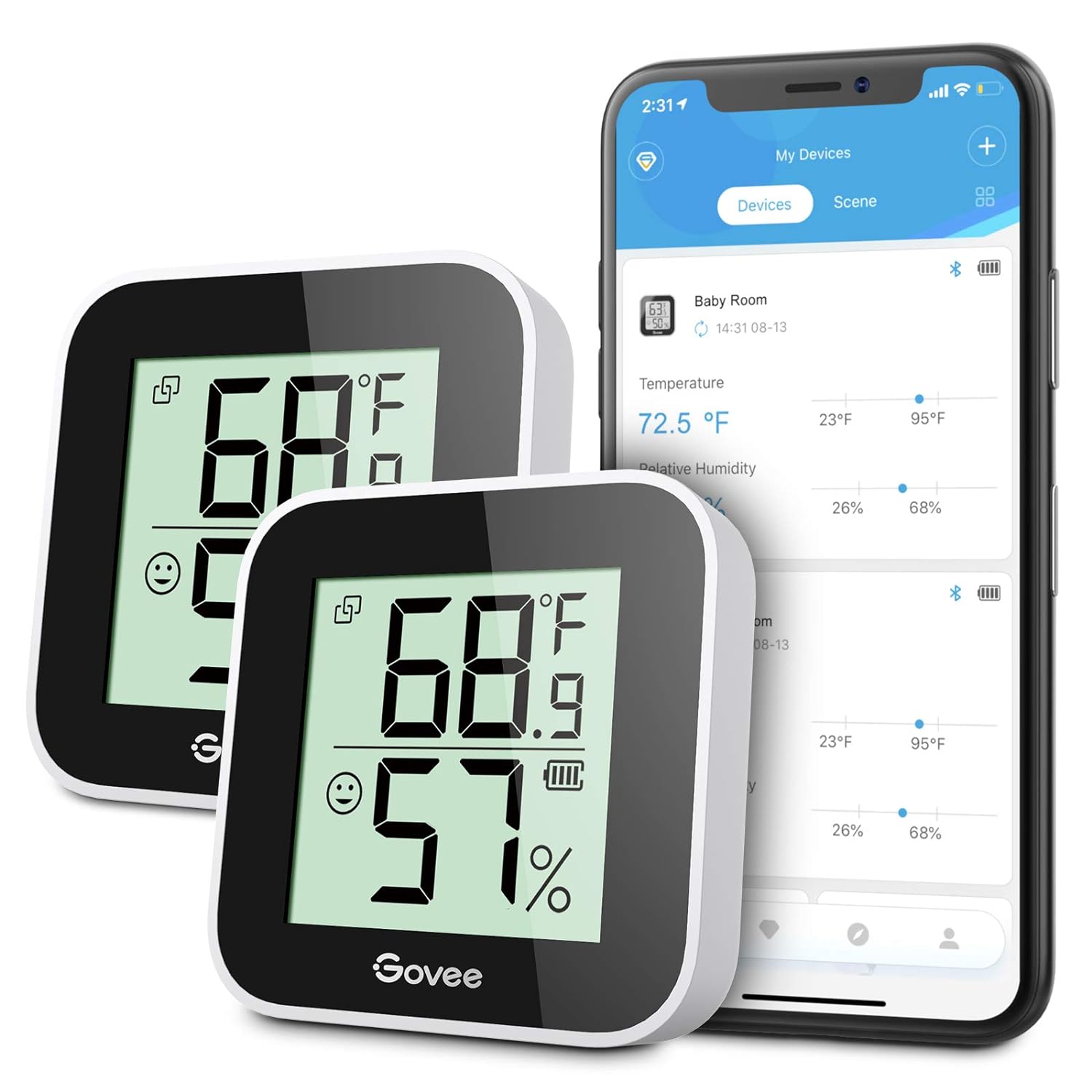
|
Govee Bluetooth Digital Set
|
|
Check Price |
|
Best Versatile
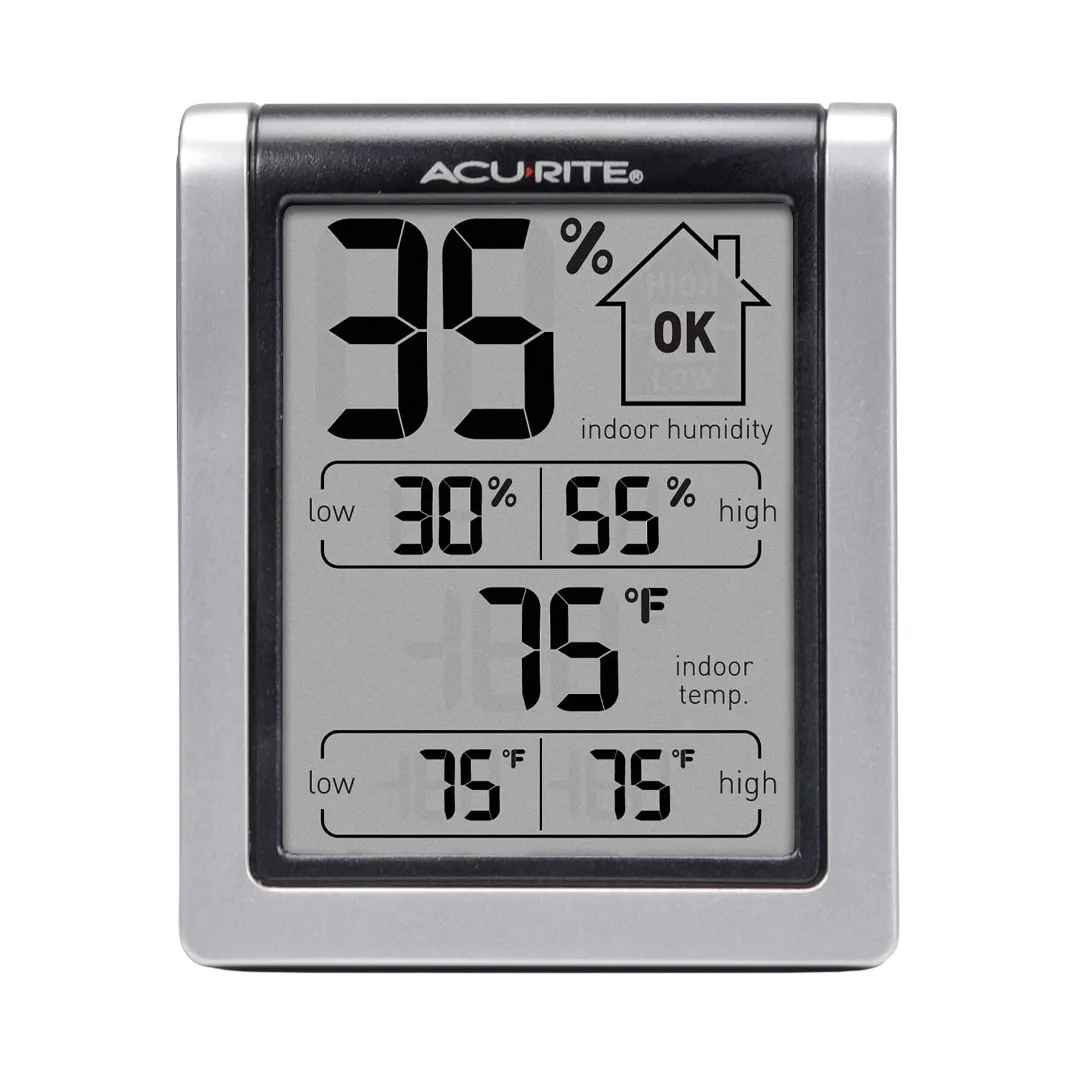
|
AcuRite 00613 Digital
|
|
Check Price |
1. ThermoPro TP49 Digital Hygrometer
We analyzed thousands of customer reviews for the ThermoPro TP49. Many customers were impressed by the device’s sturdy, sleek design and its large, clear LCD display.
However, we also encountered some negative feedback. The most frequent issue we noticed was that the TP49’s humidity sensor could be inaccurate by several points—one customer reported a discrepancy of up to 11%.
“I wanted to verify the temperature in my son’s room. His baby monitor had a thermometer that I doubted because it was near the heater. I moved the ThermoPro around the room and it matched the temperatures. The letters are big enough that I can see them from across the room. It is also small and light enough that I can bring it with me when I travel. So far the battery life has been good but I will have to wait and see. Overall I am happy with my purchase.” —Amazon Customer
“The humidity sensor shows 11% humidity right out of the box, and it only went up to 15% throughout the day. I have a professional temperature + humidity probe in a tank that has about 70% humidity and this device barely changed at all. The temperature sensor seems to be fairly accurate.” —Amazon Customer
2. ThermoPro TP55 Jumbo Touchscreen Hygrometer
The TP55 indoor thermometer has a touchscreen interface and large digital numbers that are easy to see from afar. Many verified buyers praised these features on Amazon. However, some customers also reported some issues with the product. One customer said the device became inaccurate after five years of use, while another said the batteries ran out after 10 months.
Here are some excerpts from the customer reviews:
“I love this indoor thermometer. It’s small and compact, and it can be hung on a wall or placed on a shelf or table. The temperature and humidity are very clear to read. It has a light touch blue backlight. It helps me adjust my portable space heaters. I don’t know how long the batteries will last, but I’m very happy with this product so far.” – P Merrill
“I got this in January 2018. It worked well for almost five years, but then it started to give wrong readings this past winter (2022-23). I bought the ThermoPro TP53 to replace it and check my doubts. I also have another hygrometer on my whole-house humidifier. The TP53 and the hygrometer agreed with each other, but the TP55 was way off. It showed 20% humidity when it was actually 45%. I used to think this device was perfect, but now I’m disappointed. You’ll have to make up your own mind if you want to buy it.” – A man a panama
3. Govee Bluetooth Digital Set
No products found.
Our research revealed that customers appreciated the Govee hygrometers’ smart features, which let them distinguish different units in the app. They also praised Govee’s customer service for being responsive and helpful. On the other hand, some customers reported readout discrepancies between the devices, and others were unhappy with the battery life.
“Both thermometer-hygrometers are identical and easy to set up. You don’t have to use the iPhone app if you prefer not to. The app lets you track the readings over time, and even lets you adjust the temperature and humidity values, which is very cool!” — Old-and-Wise via Amazon
“I like this hygrometer a lot. It connects to the Govee app and has a display screen. It works well and does what it’s supposed to do. But I was surprised by how often I had to change the batteries. And the battery type is not common or cheap. So I stopped using these and switched to the Govee H5100, which has no screen, but uses a regular AAA battery and lasts much longer. This is the only drawback of an otherwise excellent product. (And I don’t think it’s because of bad batteries — I use new, quality batteries from reliable sellers)” —Y via Amazon
4. AcuRite 00613 Digital
The AcuRite thermometer-hygrometer received thousands of positive reviews from verified buyers. Many users appreciated its user-friendly interface, long-lasting battery, and 24-hour data recording feature, which is especially useful for reptile owners. However, some of the most helpful negative reviews pointed out the poor quality of the back clip mount and the inaccuracy of the humidity readings, which often deviated by more than 5%.
“Clear and easy to read, even from a distance. It also looks great. Most importantly, it’s accurate! I love that it shows the highest and lowest values of temperature and humidity for the past 24 hours. That’s very helpful. Great value and fast delivery from Amazon. I bought more units and I’m very happy and pleased with my purchase. Highly recommend.” —Dave via Amazon
“This device monitors temperature and humidity well and also shows the high and low history of both. But the clip is its major flaw. It has multiple functions, but the first time I tried to use the clip as a squeeze attachment, it broke apart and the spring bar and other parts flew everywhere. I couldn’t fix it. It still works, but I have to prop it up against something and I can’t clip it to anything. For the price, I’m obviously disappointed.” —teejerman via Amazon
What Do You Need to Know When Buying a Hygrometer?
Hygrometers, while performing the essential function of measuring humidity, differ greatly in their features and models. Some key factors to consider when purchasing a hygrometer include its type (analog or digital), notification system, power sources, and additional weather readings.
Analog vs. Digital Hygrometers
Hygrometers are available in both analog and digital formats. Digital hygrometers feature screens that display numerical humidity readings, often offering more detailed information than analog models. They may also include smart home integration, data logging, built-in thermometers, and touchscreens, though these features often come with a higher price tag.
Analog hygrometers, while less information-rich, are favored by some for their classic design and low maintenance. These mechanical devices rarely need calibration and provide reliable readings.
Notifications
Some hygrometers offer push notifications to alert you of changes in indoor temperature and humidity levels. For instance, the Govee Bluetooth Digital Hygrometer connects to your smartphone, sending alerts when conditions deviate from a preset range. Without such connectivity, you’ll need to check the hygrometer manually to ensure optimal conditions.
Weather Readings
Many indoor hygrometers display additional environmental data on their LCD screens. The ThermoPro TP55, for example, shows indoor temperature, humidity, and daily high and low records, making it a versatile tool for monitoring your indoor environment.
Power Source and Battery Life
Electrical hygrometers require a power source, typically either a plug-in or batteries. Countertop models may use a 110-volt electrical connection, while others are battery-operated. For remote devices, such as those used in aquariums, battery life is crucial. Some models use rechargeable batteries, which offer the convenience of long-lasting power.
Remote Monitoring and Alerts
Monitoring humidity levels can be vital for hobbies and collections, such as wine cellars or cigar humidors. Hygrometers with remote monitoring capabilities allow you to check conditions via smartphone, ensuring you can take prompt action if humidity levels fall outside the desired range.
Interconnectivity and User Interface
Modern hygrometers can connect to personal technology through Bluetooth, WiFi, and smart home systems. Many come with dedicated apps for tracking humidity levels, which is particularly useful for sensitive environments like greenhouses. However, app usability varies, so choose one that meets your needs.
Data Logging
For those serious about maintaining optimal humidity, data logging is invaluable. A hygrometer that records humidity and temperature data can help you monitor trends and anticipate changes. Some devices store up to two years of data, which you can download, save, or print for detailed analysis.
Other Ways to Measure Humidity
While hygrometers are excellent for measuring humidity and temperature levels, other methods can also help you track this information using devices you might already own. Here are some alternative ways to measure humidity:
HVAC System Monitors
Many heating, ventilation, and HVAC systems come with built-in humidity sensors. These systems not only monitor humidity levels but often allow you to adjust them to maintain optimal indoor conditions. If your HVAC system includes this feature, you can easily keep tabs on your home’s humidity without needing a separate device.
Indoor Plants
Certain plants are sensitive to humidity levels and can act as natural indicators. For example, species like ferns or peace lilies may show signs of drooping or browning when the air is too dry. While not as precise as a hygrometer, observing your plants can give you a general sense of the humidity in your home.
Indoor Weather Stations
An indoor weather station is a comprehensive device that usually includes a hygrometer, thermometer, and barometer. These devices provide real-time humidity levels and other weather-related data, making them a valuable tool for monitoring your indoor environment.
Smart Home Devices
Many smart home devices, such as smart thermostats or home assistants like Amazon Alexa or Google Home, feature built-in humidity sensors. These devices can display humidity levels on command or via a smartphone app, integrating seamlessly into your smart home ecosystem.
Weather Websites and Apps
Online weather websites and mobile apps often provide current humidity levels based on local weather stations. While these readings may not be specific to your home, they can give you a general idea of the humidity in your area.
Types of Hygrometers
Hygrometers come in various forms, each with unique mechanisms for measuring humidity. Understanding the different types can help you choose the best one for your needs.
Electrical Hygrometers
Electrical hygrometers are the most commonly used today, known for their high-tech and accurate readings. They measure changes in electrical resistance caused by air moisture content. These devices often feature Bluetooth connectivity, allowing you to check readings from your phone, making them convenient for monitoring your home environment.
Mechanical Hygrometers
Mechanical hygrometers use organic materials like ox gut or human hair to measure humidity. These materials absorb moisture and contract or expand, moving a needle to indicate humidity levels. While they provide a general idea of humidity, they are less accurate than modern digital hygrometers.
Dew Point Hygrometers
Dew point hygrometers measure the temperature at which water condenses on a polished metal mirror. While requiring constant atmospheric conditions for accurate readings, these instruments offer precise humidity measurements. They are less common today but have historically contributed to the development of modern hygrometers.
Psychrometers
Psychrometers use two thermometers—one wrapped in a damp cloth (wet bulb) and one dry. By measuring the temperature difference between the two, they calculate relative humidity. These devices are still used in meteorology and by wildland firefighters to assess fire risk.
How We Selected the Best Hygrometers
To provide our readers with top-notch hygrometer recommendations, we followed a thorough selection process using several key sources of information. Here’s how we did it:
Initial Research
Our research began by compiling a list of hygrometers with numerous verified-buyer reviews and high average customer ratings (4–5 stars). We meticulously examined both positive and negative reviews to gain comprehensive insights from satisfied and critical buyers. This initial research helped us identify products with consistent performance and reliability.
Expert Insights
Leveraging our extensive experience, we know the value of listening to diverse opinions. To enhance our in-house expertise, we consulted reviews and videos from trusted publications and independent testers. We also spoke with subject matter experts and considered reader contributions. This multi-faceted approach ensured we gathered well-rounded and accurate information.
Final Product Selection
After gathering and analyzing data, we narrowed down our list by comparing the benefits of each product. We selected the best-in-class options that cater to various buyers, budgets, and scenarios. This final selection process ensured that we recommended only the most suitable hygrometers for different needs.
Conclusion
Selecting the best hygrometer involves careful consideration of verified reviews, expert insights, and product comparisons. By understanding the ideal indoor humidity levels, the impact of temperature on humidity, and the workings of different hygrometer types, you can make an informed choice. A reliable hygrometer helps maintain a comfortable and healthy indoor environment, protecting your home and enhancing your well-being.
Frequently Asked Questions (FAQs)
What humidity level is ideal for indoor environments?
To maintain a healthy and comfortable indoor environment, aim for around 45% humidity, according to Air Experts. If your humidity levels consistently exceed 50%, consider using a dehumidifier to prevent mold, bacteria, and other hazards. Conversely, if humidity falls below 30%, a humidifier and air purifier can help mitigate respiratory, skin, and other health issues caused by dry air.
What does a humidity reading mean?
Humidity measures the amount of moisture the air holds. For example, a reading of 33% indicates the air contains about a third of the moisture it can hold at that temperature.
How does temperature impact humidity?
Warm air holds more moisture, so humidity is typically higher in summer than in winter. This is why summer months often feel more humid.
How does a hygrometer work?
According to the Encyclopaedia Britannica, hygrometers measure humidity using various principles, such as the expansion and contraction of organic substances like goldbeater’s skin or human hair in response to humidity changes. Digital hygrometers often use electrical sensors to provide readings.
Are hygrometers accurate?
The accuracy of hygrometers varies by type and quality. Digital hygrometers are generally more accurate than analog ones. Selecting a high-quality hygrometer with a good reputation for accuracy is crucial for precise humidity monitoring.
Can hygrometers measure both humidity and temperature?
Yes, many hygrometers measure both humidity and temperature, offering dual readings. This feature allows you to monitor ambient temperature alongside humidity levels, providing a comprehensive view of your indoor environment.




